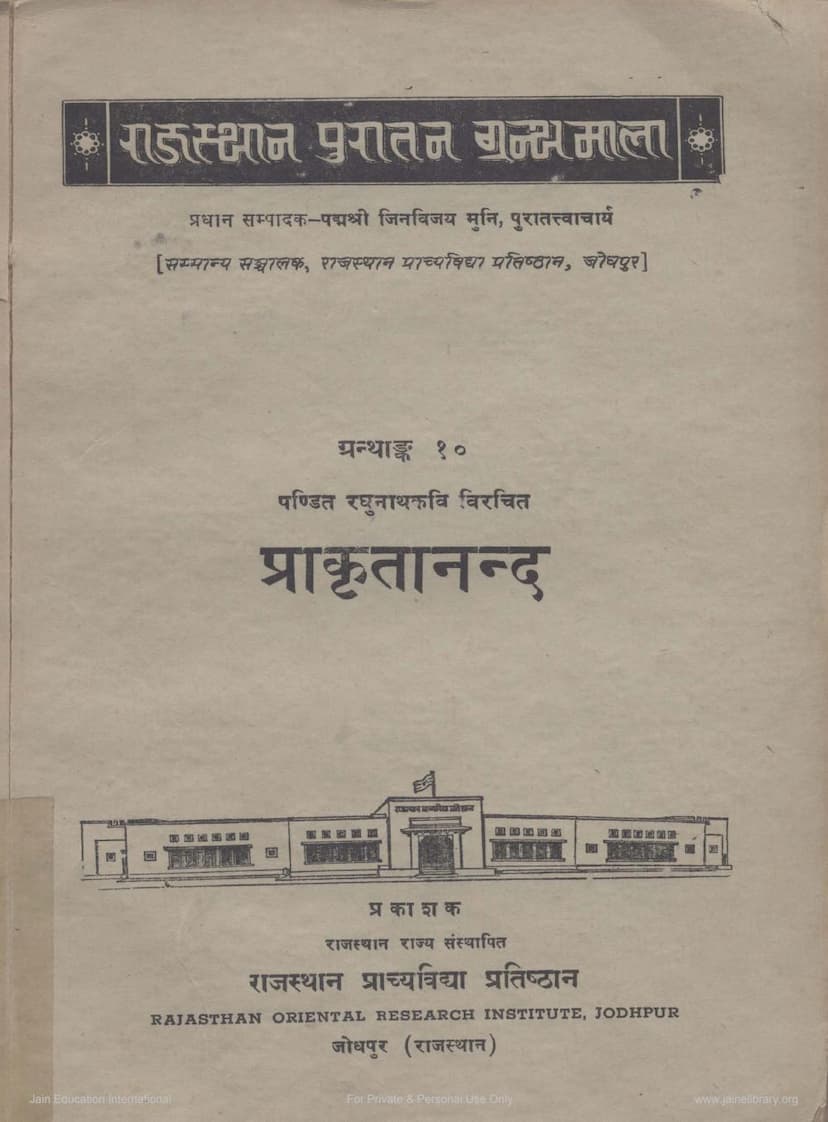Prakrutanand
Added to library: September 2, 2025

Summary
This document is a detailed description and partial transcription of the Jain text "Prakrutanand," authored by Pandit Raghunath Kavi. Published by the Rajasthan Oriental Research Institute, Jodhpur, as part of the "Rajasthan Puratan Granthamala" series (Volume 10), it presents a concise grammar of the Prakrit language.
Here's a comprehensive summary based on the provided pages:
Book Title: Prakrutanand Author: Pandit Raghunath Kavi (who also used the title "Kavi-kanthirav") Publisher: Rajasthan Oriental Research Institute, Jodhpur Series: Rajasthan Puratan Granthamala, Volume 10 Editor: Padmashree Jinavijay Muni, Puratattvacharya
Overall Purpose and Content:
- Prakrutanand is a brief grammatical treatise on the Prakrit language.
- The author, Pandit Raghunath Kavi, son of Jyotirvid Saras, aimed to create a text for those who, despite being born into scholarly families, possess limited intellect but desire to appreciate literature.
- It serves as a procedural compilation based on Vararuci's "Prakrit Prakash," adapting its style in a manner similar to Sanskrit grammars like "Laghu Kaumudi."
- The text covers various aspects of Prakrit grammar, including noun declensions (declining nouns ending in vowels and consonants for masculine, feminine, and neuter genders), case endings, verb conjugations, and indeclinables (Nipata).
- It includes detailed indices of its own sutras, a comparative index of sutras with "Prakrit Prakash," and a comprehensive index of Prakrit words with their Sanskrit equivalents, referencing the specific sutras applicable to them.
Key Information from the Introductory Sections:
- Discovery and Publication: The manuscript was discovered by Muni Shri Punyavijayji Maharaj, likely in Bikaner. He made a handwritten copy in Samvat 1726 (1669 CE) in Lahore. Muni Jinavijay later received this copy and decided to publish it in the Rajasthan Puratan Granthamala. The publication process was delayed, with the book finally reaching readers about 10 years after the manuscript's acquisition.
- Significance of Prakrit: The text highlights the vastness of Prakrit literature, with thousands of works covering diverse subjects. While not as prominent in Brahmanical traditions, Prakrit was central to Jain and Buddhist traditions. Buddhist Prakrit is known as Pali, while Jain Prakrit literature is often referred to broadly, with specific classifications like Ardhamagadhi and Maharashtri.
- Influence on Modern Languages: The introduction states that all existing Aryan languages, besides Dravidian languages, originated from this ancient Prakrit. Prakrit was the mother tongue of the Aryan-speaking Indian populace from the time of Lord Buddha and Lord Mahavir.
- Comparison with "Prakrit Prakash": "Prakrit Anand" contains 416 sutras. It omits some sutras found in "Prakrit Prakash" (specifically, 87 sutras from the Chaukhambha edition) but also includes 21 sutras not present in that widely known version. A comparative index of sutras is provided for scholars.
- Author's Plea for Tolerance: The editor includes a quote from Raghunath Kavi at the beginning of the work, asking readers not to discard the text due to imperfections, drawing an analogy to not discarding water just because it has a bit of moss.
Structure and Content Breakdown (from Indices):
-
Table of Contents (Vishayavivaranam):
- Introductory Statement (Prastavikaktavyam)
- Index of Sutras of Prakrutanand (Prakrutanandasy Sutranukramanika)
- Comparative Index of Sutras of Prakrutanand and Prakrit Prakash (Prakrutanand-Prakritprakashayoh Sutranam Bhedanukramanika)
- First Chapter (Prathame Parichchhede): Covers declension of nouns ending in vowels (pulled, feminine, neuter), nouns ending in consonants (pulled, feminine, neuter), and indeclinables (Nipata).
- Second Chapter (Dwitiye Parichchhede): Deals with verb conjugation (Dhatu Prakaranam).
- Appendix (Parishishtam): Index of Prakrit Words (Prakritshabdannukramanika).
-
Sutra Index (Prakrutanandasy Sutranukramanika): This is a lengthy section listing sutras by number, their corresponding sutra text, and the page number where they appear. The sutras cover a vast range of grammatical rules, including sandhi (euphony), noun declensions, verb roots, and the formation of various word forms in Prakrit.
-
Sutra Comparison (Prakrutanand-Prakritprakashayoh Sutranam Bhedanukramanika): This section provides a side-by-side comparison of sutras from "Prakrutanand" and "Prakrit Prakash," noting where they align and where they differ.
-
Prakrit Word Index (Prakritshabdannukramanika): This is an extensive glossary listing Prakrit words, their Sanskrit equivalents, and the sutra numbers that govern their formation. This is a highly valuable resource for understanding the vocabulary and grammatical principles of Prakrit as presented in this work.
Key Grammatical Points Illustrated (from Transcription):
The transcribed sections showcase specific Prakrit grammatical transformations, such as:
- Sandhi rules (e.g., assimilation of 'm' to 'n', loss of certain consonants).
- Changes in vowels and consonants in different cases and tenses.
- The use of specific Prakrit affixes and root changes.
- Examples from common words like "Narayan" (Narayana), "Ragah" (Raga), "Agni" (Agni), "Surya" (Surya), "Yama" (Yama), and "Atman" (Atman).
In essence, "Prakrutanand" is a significant scholarly contribution to the study of Prakrit grammar, offering a practical and comparative approach based on earlier foundational works, presented in a methodical manner.